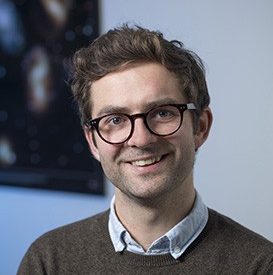
Dr Luke Davies
Astrophysicist Dr Luke Davies last night won a prestigious Young Tall Poppy Science Award for his research into the history of the Universe.
Dr Davies, who is based at The University of Western Australian node of the International Centre for Radio Astronomy Research (ICRAR), is trying to understand how galaxies have evolved over the last eight billion years.
Dr Davies and his colleagues create huge maps of the Universe with observations from optical telescopes.
They then overlay these maps with observations at other wavelengths from the ultraviolet, infrared and radio, using data from some of the world’s largest telescopes, including precursors to the Square Kilometre Array.
This allows Dr Davies to study how many stars galaxies have, how many new stars they are forming, and how much dust and gas they contain.
He can look at what happens when galaxies collide, how the location of a galaxy affects its stars and how dark matter is distributed in the Universe.
“Because it takes a very long time for light to reach us, the further you look into the Universe, the further you look back in time,” Dr Davies said.
“So we can build a picture of how these processes have changed over the history of the Universe.”
Dr Davies leads two international telescope surveys, each involving large teams of scientists from around the world.
The first—the DEVILS survey—uses the Anglo-Australian Telescope to observe ~60,000 galaxies and work out their positions in the Universe.
The second—the WAVES-Deep survey—will cover ten times the area of DEVILS, observing nearly a million galaxies using a European Southern Observatory (ESO) telescope called 4MOST, taking advantage of Australia’s new partnership with ESO.
Dr Davies said galaxies like our own Milky Way look very different to galaxies 10 billion years ago.
“We’re trying to work out how you actually form a galaxy like the Milky Way, and all the other galaxies we see in the local Universe” he said.
“Ultimately that leads into how you form stars like the Sun and planetary systems—it’s basically trying to work out how we got to where we are, right now.”
Dr Davies moved to Western Australia from the UK five years ago, attracted by the sunshine and ICRAR’s reputation as an exciting young research institution.
He has also been a passionate supporter of outreach programs, taking part in countless school and public astronomy events, and has shared a stage with world-famous science communicator Dr Neil de Grasse-Tyson and physicist Professor Brian Greene.
Dr Davies was presented with the Young Tall Poppy Science Award last night at the WA Shipwrecks Museum in Fremantle.

